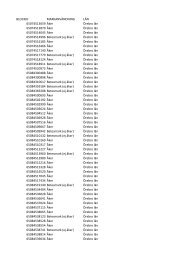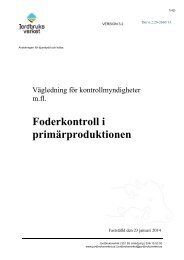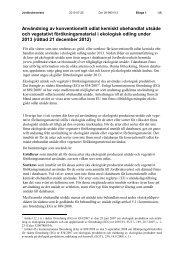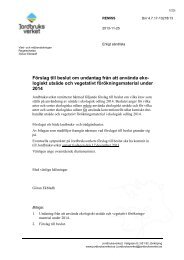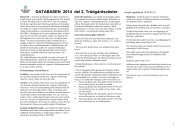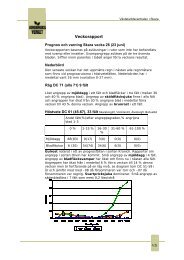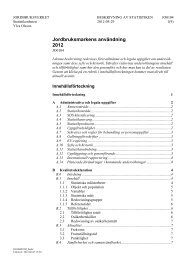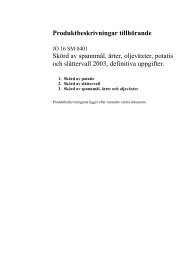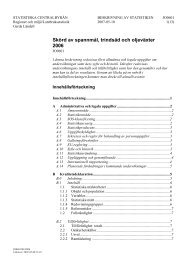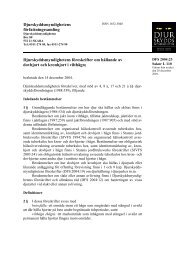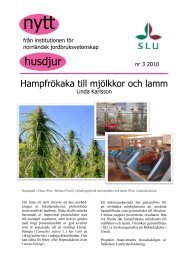Humlor på ekologiska och konventionella gårdar - Jordbruksverket
Humlor på ekologiska och konventionella gårdar - Jordbruksverket
Humlor på ekologiska och konventionella gårdar - Jordbruksverket
You also want an ePaper? Increase the reach of your titles
YUMPU automatically turns print PDFs into web optimized ePapers that Google loves.
<strong>Humlor</strong> <strong>på</strong> <strong>ekologiska</strong> <strong>och</strong> <strong>konventionella</strong> <strong>gårdar</strong> - Jens O. Risberg<br />
Abstract<br />
Bumblebees (Bombus) on organic and conventional farms<br />
– the effect of farming practice and landscape on keystone pollinators<br />
During the last 50 years the agricultural landscape in Sweden has undergone large changes<br />
with negative consequences for diversity. Reports of biodiversity losses have caused great<br />
concern as many species contributes to important ecosystem services. One alternative to conventional<br />
farming practices that has been proposed is organic farming.<br />
Many crops are largely dependent on insect pollination. Therefore reports of declines of many<br />
insect pollinators are worrying. In Sweden, bumblebees (Bombus spp.) are the most important of<br />
the wild pollinators. Hence, this study concerns species richness and abundance of bumblebees<br />
on organic and conventional farms.<br />
Five organic and five conventional farms were paired in order to compare the two farming<br />
systems. Landscape heterogeneity was calculated for each farm, both on a large scale (5×5 km)<br />
and on a small scale (400×400 m). The study was performed during the summer of 2002 in the<br />
province of Uppland, central Sweden. Leys with clover (Trifolium sp.) were the floral resource<br />
growing on all the farms. Hence, leys together with a neighboring area with natural floral<br />
resource were chosen as study objects. Bumblebees were surveyed through bee walk transects.<br />
The abundance of bumblebees was significantly larger on organic farms, mainly because of the<br />
abundance of white clover (T. repens) in organically managed leys. The flowering period of white<br />
clover lasts longer than that of red clover (T. pratense). These findings suggest that to get strong<br />
populations of bumblebees continuous flower resources during the entire summer are important.<br />
There were no differences in species richness between the farming systems but the number of<br />
species increased with increasing large-scale landscape heterogeneity. All species occurring in the<br />
agricultural landscape of Uppland were observed in this study including three species on the<br />
Swedish red list, B. subterraneus, two individuals of B. distinguendus and B. muscorum, which was the<br />
first observation in Uppland since the 1950s, while B. subterraneus is among the more frequent<br />
species in this study.<br />
Most of the flower visits in the natural foraging resources were to leguminous flowers,<br />
especially red and white clover. This shows that leys with clover are good foraging resources for<br />
bumblebees. Long-tongued bumblebee species such as the threatened B. subterraneus and B.<br />
distinguendus paid more visits to broad bean (Vicia faba).<br />
Actions that are recommended as beneficial for bumblebees, and hence pollination as an<br />
ecosystem service, include: 1) Increase the amount of ley with clover in the crop rotation. 2) Include<br />
white clover in the leys, which will result in earlier and longer flowering period. 3) Increase<br />
the diversity of flower resources through flower-rich field margins. 4) When harvesting the ley,<br />
leave smaller parts as flower resources for bumblebees. 5) Use broad bean as fodder instead of<br />
peas to favor especially long-tongued bumblebee species.<br />
Keywords: Bumblebees, Bombus, organic farming, landscape ecology, biodiversity, diversiy,<br />
abundance, ecosystem services, farming practice, ley, clover, Trifolium, red clover, Trifolium pratense,<br />
white clover, Trifolium repens<br />
Corresponding author: Jens O. Risberg, e-mail: jens.risberg@telia.com<br />
2



